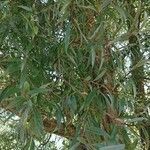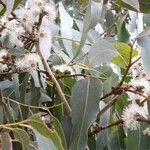Tree to 50 m with grey, white or yellowish white smooth bark throughout or rough at base or on most of the trunk.. Juvenile leaves opposite, sessile, lanceolate, cordate or amplexicaul; adult lanceolate, 12–20 cm long, 0.8–2 cm wide; petiole terete or slightly flattened, 1–2.5 cm long.. Umbels 3-or 7-flowered; peduncle angular or flattened, 4–8[12] mm long; [pedicels 1–4 mm long].. Buds ovoid; operculum conical or hemispherical, 3–4 mm long, 3–5 mm wide, apiculate.. Calyx-tube hemispherical or campanulate, 2–3 mm long, 3–5 mm wide.. Fruits hemispherical to subglobular, 5–8 mm long, 5–9 mm wide with broad ascending disc and 3–4 exserted valves.. Fig. 10/41, p. 49.
Tree to 50 m. Bark smooth throughout, grey, white or yellow-white, or rough, fibrous on lower or whole trunk, or rough to larger branches. Juvenile leaves opposite, sessile, lanceolate, cordate or amplexicaul, green, slightly discolorous. Adult leaves alternate, lanceolate or narrowly lanceolate, acuminate, green, concolorous. Umbels 3-or 7-flowered; pedicels absent or very short. Buds ovoid; operculum conical or hemispherical, apiculate; hypanthium hemispherical or campanulate. Fruits hemispherical to subglobular; disc broad, ascending; valves 3 or 4, exserted.
A medium to tall tree. It can grow 10-70 m tall. It spreads 8-15 m wide. The bark is smooth and whitish. It has some rough bark at the base of the trunk. The upper limbs shed bark in long strips. The branches are long and slender. Young leaves are opposite with the base wrapped around the stem. They are bright green. The adult leaves are long, dark green and sword shaped. They are 10-15 cm long. The flowers are in groups of 3. They are small and cream or white. The capsule is 5-8 mm wide. It is almost round. It has pointed valves which stick up.



